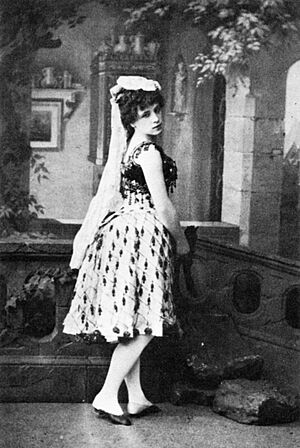Virginia Zucchi facts for kids
Virginia Zucchi (born February 10, 1849 – died October 12, 1933) was a famous Italian dancer. She was a ballerina from 1864 to 1898. People called her “the Divine Zucchi” or "the Divine Virginia" because she was so artistic, expressive, and skilled. One of her most famous performances was in La Esmeralda pas de six. This dance was created just for her by Marius Petipa with music by Riccardo Drigo in 1886. Virginia Zucchi performed in many big cities like Berlin, London, and Paris. She also helped bring Italian ballet techniques to Russia.
Contents
Early Life and Training
Virginia Zucchi was born in Cortemaggiore, Italy. She started learning ballet in Milan. Her teachers included famous ballet masters like Lepri and Carlo Blasis. In 1864, she had her first big performance in Varese. After that, she danced all over Italy, and also in cities like Berlin and Paris.
Dancing in Russia
In 1885, Virginia Zucchi traveled to St. Petersburg, Russia. She danced there during the summer at a theater called Kin Grust. This theater was used when the main Imperial Theatre was closed for the summer.
Zucchi became very popular in Russia. The Tzar (the Russian emperor) saw her dance and was so impressed. He asked her to join the Maryinsky Theatre, which was the official Imperial Theatre in Russia. She danced there until 1888.
Famous Performances
While at the Imperial Theatre, Virginia Zucchi performed in many important ballets. These included:
- A Trip to the Moon (1885)
- Padmana in Brahma (1885)
- Coppelia
She also starred in many ballets created or revived by Marius Petipa, a very famous choreographer. Some of these were:
- The Pharaoh's Daughter (1885)
- La Fille Mal Gardée (1885)
- La Esmeralda (1886)
- The King's Command or The Pupils of Dupré (1887)
On one special occasion, under Petipa's direction, Zucchi performed an entire solo dance completely en pointe. This means she danced only on the tips of her toes, which was a very difficult and impressive feat.

Later Career and Influence
After her time with the Imperial Ballet, Zucchi continued to dance. She performed in Moscow and St. Petersburg with her own dance company in the late 1880s and early 1890s.
In 1891, she was asked by Cosima Wagner to create the "Bacchanal" dance for the opera Tannhäuser. This was for its first performance at the Bayreuth Festival. She also performed at the famous Palais Garnier (Opera of Paris) in 1895. Her very last performance was in Nice, France, in 1898.
Virginia Zucchi had a big impact on the St. Petersburg ballet school. Her amazing technique and artistry inspired the school to expect even more technical skill from its dancers.
Retirement and Legacy
After she stopped performing, Virginia Zucchi moved to Monte Carlo. There, she opened her own ballet school and became a teacher.
Her dancing greatly influenced many ballerinas who came after her. One of them was Mathilde Kschessinska, another very famous dancer. Kschessinska saw Zucchi dance when she was fourteen years old and was deeply inspired. She said that after seeing Zucchi, she worked with "fire, energy and application" because her dream was to dance just like her. Kschessinska felt that because of Zucchi, she had "complete mastery of technique" when she finished ballet school.
Virginia Zucchi passed away in Nice in 1933.
Images for kids





